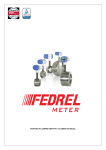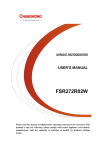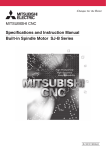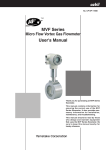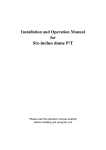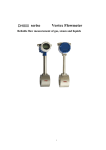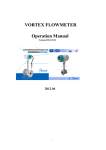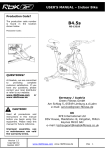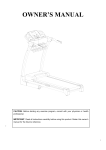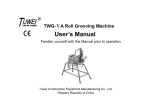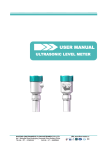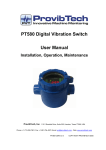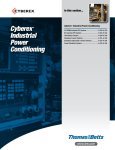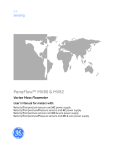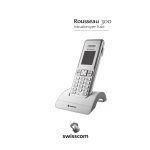Download VORTEX FLOWMETER USER MANUAL
Transcript
Kaifeng Kaide Flow Instrument Co.,Ltd No2. Indusrtial Road, Huanglong Industrial Park, Kaifeng County, Henan, China Tel: 86-378-3212788 Fax: 86-378-6682432 VORTEX FLOWMETER USER MANUAL 1 CONTENTS 1. Introduction ········································································································3 2. Measuring principle principle·····························································································3 3. Technical parameters parameters···························································································3 4. Lectotype instruction instruction··························································································· 4 4.1 Selection of nominal diameter:···············································································4 4.2 Confirm the suitable configuration········································································· 5 4.3 The calculation of transducer pressure loss································································5 4.4 Liquid phase guaranteed·························································································6 4.5 Example of diameter selection·················································································6 5. Installation method and steps steps············································································· 6 5.1 Choose the right installation site·············································································· 6 5.2 Installation notes··································································································· 8 5.3 The outline dimensional drawing of transducer for reference when mounting················ 8 5.4 The selection of pressure and temperature measuring point········································· 9 6. Connecting of signal wire wire···················································································· 10 7. Debugging of transducer transducer····················································································· 11 8. Trouble shooting shooting···································································································12 9. Intelligent flow totalizer totalizer······················································································ 12 10. Wireless remote flow monitoring system system·························································· 13 11. Back-up power supply supply························································································ 13 12. Lectotype Codes Codes·································································································· 14 13. Appendix Appendix············································································································· 14 The manual of compact local LCD vortex flowmeter flowmeter···········································17 2 1. Introduction Stress type vortex flowmeter is a kind of velocity type flowmeter, based on Karman vortex street theory, adopt piezoelectric crystal to measure the vortex frequency produced by fluid flowing through the triangular prism in the pipeline, then the flow value can be measured. Vortex flowmeter is widely applied in industries like petroleum, chemical, light industry, power supply, heat supply, etc.. It has the characteristics as follow: High accuracy, wide range; Wide medium application, able to measure liquid, gas and steam; High operating temperature, the temperature of fluid up to 350℃; No moving parts, no abrasion, high reliability; Stainless steel shell, corrosion resisting. 2. Measuring principle: When the fluid flows through vortex generator(the triangular prism) in the pipeline, as partial flowrate go up, a vortex pattern appears(as shown in fig.1), the vortex alternatively appears as two columns, it is called Karman Vortices. The vortex alternatively segregates, a fluctuating force is produced in the wake flow behind the prism, the detecting probe installed behind(or in) the prism is affected by this tiny fluctuating force and the piezoelectric crystal parts buried in the probe is affected by the alternative stress, then a alternating charge signal is generated. The detector amplifier transforms, amplifies, wave filtering and signal reshaping this signal, then outputs a voltage(or current) pulse signal with a frequency same as that of vortex shedding frequency or outputs an analog current signal which has a proportion with vortex shedding frequency. Each pulse or every certain current the meter outputs stands for certain volume of measured fluid. The total pulse or the integration of analog current in a certain period of time stands for the total flow of the fluid in it. The discharge rate of Karman Vortex Street is related to the width of triangular prism and the flowrate of the fluid, but have nothing to do with parameters like fluid temperature and pressure. It can be expressed by the formula as below: f=StV/d Thereinto: f----the frequency of Karman Vortex Shedding St----Strouhal Number V----velocity d----width of the triangular prism Strouhal number(St) is a important parameter of vortex flowmeter, it is only related to Reynolds number(Re). Only if Re is between 2 × 104 and 7 × 106, keeps being a constant(0.17~0.18). In this case, the flowrate can be measured through measuring vortex frequency signal and the flow can be worked out through the flowrate of the fluid. 3. Technical parameters: 3 Nominal diameter: DN15, DN20, DN25, DN32, DN40, DN50, DN65, DN80, DN100, DN125, DN150, DN200, DN250, DN300, DN350, DN400, DN450, DN500; Application: gas(air, oxygen, nitrogen, coal gas, natural gas, chemical gas, etc.), liquid(water, high temperature water, oil, beverage, chemical liquid, etc.), steam(saturated steam, superheated steam); Fluid temperature: -40℃~+280℃, -40℃~+350℃; Nominal pressure: ≤1.6MPa, ≤2.5MPa, ≤4MPa; Accuracy: ±0.5% for liquid and gas, ±1.0% for steam; Flowrate range: 0.27~9m/s for liquid, 3~80m/s for gas, 3~90m/s for steam; Measuring range: refer to table2; Signal output: Voltage pulse: low level≤1V, high level≥6V, pulse width 0.4ms, load resistance>150Ω; Standard current: 4~20mA, conversion accuracy ± 0.5% full scale value, load resistance 24V~500 Ω , local LCD display: 5-bit display of instantaneous flow(m3/h, kg/h, t/h), conversion accuracy±0.1%; 5-bit display of cumulative flow(m3,kg,t), conversion accuracy ±0.1%; Power supply: Voltage pulse output: +12VDC; 4~20mA output: +24VDC; Local LCD display: 3.6V 5# lithium battery powered, have a service life over 2 years. Ambient temperature: Voltage pulse output: -30℃~+65℃; 4~20mA output: -10℃~+55℃; Local LCD display: -25℃~+55℃; Body material: 1Cr18Ni9Ti(others refer to contract) 4. Lectotype instruction 4.1 Selection of nominal diameter: When the diameter of transducer is different, the measuring range is different. And the measuring range of transducer with a certain diameter varies with the fluid difference, operating temperature and pressure, etc. 4.1.1 For saturated steam, when one of operating temperature and pressure, a rough flow range are known, the transducer diameter can be confirmed through table look-up(refer to table 1); For superheated steam, when the operating temperature and pressure are known, look up table 2 to confirm density, along with flow range, look up table 1 to confirm the transducer diameter.(Note: The pressure values in table 1 are absolute pressure, which is the sum of pipeline pressure and atmospheric pressure.) 4.1.2 For gas and liquid, when the medium conditions are inconsistent with that in the tables or other medium applied, the measurement of flowmeter will be affected by medium density and viscosity. The flow range is needed to be confirmed in advance, then look up table 3 to confirm the transducer diameter. In this case, flow range can be confirmed in the following way: 4 A. lower limit flow value: 1 According to the lower limit flow Qmin , fiducial medium density ρ 0(the density of gas ○ medium is 1.293Kg/m3 and liquid medium 1000Kg/m3) and the measuring medium density ρ given in table 1, the lower limit flow Qminρ can be worked out through the formula given below: Qminρ= Qmin ×(ρ0/ρ)1/2(m3/h) 2 According to kinematic viscosity of medium V, the lower limit flow Qmin can be worked ○ out through the formula given below: QminV= 6VD×104(m3/h) Thereinto: D---- pipe inside diameter(mm) Compare Qmin ρ and QminV, choose the higher value as the lower limit flow value of certain type of flowmeter. B. upper limit flow value: Generally, the upper limit flow value of liquid is 9m/s, gas 80m/s and steam 90m/s. 4.2 Confirm the suitable configuration A. Choose the right type: remote transmission or local display; B. For remote transmission type, if the fluid is saturated steam, choose automatic temperature compensation density; if the fluid is superheated steam, choose temperature and pressure compensation density; for other medium, whether compensation is needed or not depend on the practical situation; if the accuracy requirement is low and temperature or pressure is constant, choose fixed pressure or fixed temperature compensation, fixed density compensation is also suitable; C. For intelligent flow totalizer, if display requirement is only for flow, pressure, temperature, etc., choose nixie tube display or LCD intelligent totalizer; if memory function is needed to chasing historical data, choose intelligent flow totalizer paperless recorder; D. Whichever type of intelligent flow totalizer is chosen, a RS485 or RS232 communication interface should be considered to be installed; E. Whichever type of intelligent flow totalizer is chosen, a back-up power should be considered to be deployed in order to keep the instrument properly functioning when there is a power failure(the working life varies with different configuration, normally 24~48 hours or above); F. When choosing intelligent flow totalizer, an instrument box should be considered to be provided to put the intelligent flow totalizer in to avoid the set parameter being randomly adjusted; G. When choosing remote transmission type, a wireless remote flow monitoring system should be considered to be applied to realize real-time monitoring and management of flow in each pipeline; H. If the measured medium is explosive and flammable material or there is explosive and flammable gas in the measuring environment, explosion-proof transducer and measuring system should be applied. 4.3 The calculation of transducer pressure loss After confirming the transducer diameter, the transducer pressure loss can be worked out to figure out whether transducer has a impact on process pipeline. 5 The formula is as below: P≤1.2ρV2 Thereinto: ΔP---- transducer pressure loss(Pa) ρ---- fluid density(Kg/m3) V ---- the average velocity of fluid 4.4 Liquid phase guaranteed In order to avoid vaporization or gas etching, the fluid pressure of the flowmeter should meet the requirement of the following formula: P>2.6Δp+1.25Ps Thereinto: Ps---- the saturated steam pressure of the liquid, which correspond with certain temperature(KPa) P ---- pressure of the fluid(Pa) 4.5 Example of diameter selection Eg.1: The inside diameter of process pipeline is DN100, medium is saturated steam, steam consumption is around 0.5t/h~3t/h, instrument pressure is 0.4MPa, please confirm the proper instrument diameter. Solution: From instrument pressure 0.4MPa, we know the absolute pressure is 0.5MPa, look up table 2 to find out the temperature is 152℃. As flow range of DN100 is 0.4~3.5t/h, totally meet the operating requirement, a vortex flow transducer with a diameter of DN100 should be chosen here. If the steam consumption is around 0.3t/h~2t/h, choose the ones with a diameter of DN80, the process pipeline diameter should be deducted from DN100 to DN80. Eg.2: The inside diameter of process pipeline is DN100, medium is superheated steam, steam consumption is around 0.5t/h~2.8t/h, instrument pressure is 0.4MPa, temperature is 220℃, please confirm the proper instrument diameter. Solution: Based on instrument pressure(0.5MPa) and temperature(220℃), look up table 3 to find out the density:2.66. Then look up table 2 to get the flow range: 0.4~3.5t/h, totally meet the operating requirement, a vortex flow transducer with a diameter of DN100 should be chosen here. If the steam consumption is around 0.3t/h~2t/h, choose the ones with a diameter of DN80, pipe reduction would be needed here. 5. Installation method and steps 5.1 Choose the right installation site: When choosing installation site, pay attention to the following points: A. The installation site should be in the location with no or little vibration, the vibration acceleration should be no more than 2g, if exceeded, adopt vibration reducing measures; B. There should be enough straight pipe for both upstream and downstream(refer to fig.2); C. Service valve should be installed at the upstream of transducer and regulating valve downstream; D. Choose the most convenient location for installation and maintenace as possible; E. Dry location is more suitable; F. Transducer can be installed at both the horizontal and vertical pipelines. When being installed at the vertical pipeline, fluid(liquid) must flows from bottom to top; 6 G. Transducer is better installed indoor, pay attention to water proof if it must be installed outdoor, cable outside the amplifier box should be bowing; H. Transducer should be kept away from electrical noise, such as high power inverter, high power transformer, electromotor and high power wireless transceiver. The requirement of straight pipe: 1. Converging pipe The length of straight pipe should be ≥ 15D for upstream and ≥ 5D for downstream if converging pipe(>150) is installed in the upstream of transducer installation site; upstream downstream 2. Diverging pipe The length of straight pipe should be ≥ 18D for upstream and ≥ 5D for downstream if diverging pipe(>150) is installed in the upstream of transducer installation site; 3. 900 elbow or T joint The length of straight pipe should be ≥20D for upstream and ≥5D for downstream if a 900 elbow or T joint is installed in the upstream of transducer installation site; 4. Two 900 elbow are (on the same plane) The length of straight pipe should be ≥25D for upstream and ≥5D for downstream if two 0 90 elbow are on the same plane in upstream; 5. Two 900 elbow are (on different plane) The length of straight pipe should be ≥40D for upstream and ≥5D for downstream if two 0 90 elbow are on different plane in upstream; 7 6. Control valve Flow or pressure control valve should be installed at least 5D away from the meter, if the valves must be installed in upstream, the length of straight pipe should be ≥ 50D for upstream and ≥5D for downstream; 7. Rectifier The length of straight pipe should be ≥ 8D for upstream and ≥ 5D for downstream if a rectifier is installed in upstream; 5.2 Installation notes A. When welding flange with straight pipe, demount transducer; B. When mounting transducer, make sure the flow direction arrow on the shell is in accordance with the flow direction in the pipeline; C. After welding flange, clean the pipeline, make sure there are no impurities like welding slag in the pipeline; D. Before mounting transducer, make sure a sealing washer is put in the groove of the flange. 5.3 The outline dimensional drawing of transducer(fig.3 and table 5),for reference when mounting. 8 Table 5: The outline dimension of general instrument DN B0 C0 D0 H0 matched with seamless steel tube 15 65 101 125 422 φ18×1.5 20 65 101 125 422 φ26×3 25 65 101 125 422 φ32×3.5 32 70 110 145 427 φ38×4 40 75 115 145 427 φ45×2.5 50 75 117 160 435 φ57×35 65 75 123 180 445 φ73×4 80 84 132 296 450 φ89×4.5 100 90 138 230 474 φ108×4 125 100 152 245 482 φ133×4.5 150 120 174 280 499 φ159×4.5 200 150 206 336 526 φ219×9 250 160 216 406 563 φ273×10 300 170 228 460 590 φ325×12 5.4 When transducer, along with pressure transmitter and temperature transmitter, constitutes a measuring system, the selection of pressure and temperature measuring point refer to the following fig.. 5.4.1 The installation of pressure transmitter A. Open a pressure transmitting hole(around φ12) at the certain spot on the pipe given in fig.6; B. Weld pressure transmitting block to the pressure transmitting hole, avoid leakage; C. Mount needle valve; 9 D. Mount run; E. Close the needle valve, inject cold water into the run; F. Mount pressure transmitter; 5.4.2 The installation of platinum thermal resistor A. Open a small hole at the certain spot on the pipe given in fig.6, the diameter of the hole should be slightly greater than the outer diameter of platinum thermal resistor(around φ40); B. Weld the platinum resistance base to the hole, ensure the bottom end of the base is in the centreline of pipe. The method of installing pressure transmitter and platinum resistance to horizontal pipe The method of installing pressure transmitter and platinum resistance to vertical pipe 6. Connecting of signal wire 8BVPV3 × 0.5 signal transmitting wire is provided along with transducer, therein: the red wire is the positive power supply, the black wire is the negative power supply, others are frequency signals. The wire mode of transducer, pressure transmitter and platinum thermal resistor is as shown in fig.7. The shielded cable should be as far away from highfield as possible and being laid with highline is strongly prohibited. The shielded cable should be as short as possible and avoid being rolled, so that the distributed capacitance can be reduced. The cable length is better less than 500m(for voltage pulse type), please consult with us if you need more. 10 Fig.7: The wire mode of transducer, pressure transmitter and platinum thermal resistor 7. Debugging of transducer Generally, there is no need of zero setting as the transducer is often well adjusted before leaving factory. However, when the ambient condition changes and the instrument functions 11 abnormally, reset zero point as described below: Power on the transducer, fill the process pipeline with medium, close the valve in downstream of transducer(close the one in upstream instead if it is unable to be closed), widdershins adjust the potentiometer SF(near the terminal) to the end, at this moment, there are signals of disturbing pulse output(for 4~20mA output type, use a multimeter to check if there is pulse output from the first circuit board, if not, adjust the potentiometer pointer to R to make the signal output 4mA, R stands for the potentiometer being adjust to the full scale value), then slowly deasil adjust SF till there is no output. Open the valve, the instrument would normally function. 8. Trouble shooting Malfunction 1: There is flow in the pipeline, yet no output from transducer or no display of intelligent flow totalizer: A. Make sure there is flow in the pipeline and the flow value is higher than the lower limit of measurable flow; B. Check if there are any misconnections or brokens of wire: the basic method is to check the wire or beat the pipeline with a hammer or stick, adjust the totalizer to display frequency to see if there is frequency displayed, if there is, then no wire misconnection; if not, check the wire; C. Check the amplifier: remove the probe wire from amplify board to see if there is output from transducer or 50Hz frequency display of intelligent flow totalizer, if not, change the amplify board, if there is, then the amplifier is well functioning; D. Check the transducer: remove the two lead wires of transducer from amplify board, use a multimeter to measure the resistance between the two lead wires and the respective resistance of them, both of which should be more than 2MΩ, otherwise, the transducer should be replaced; E. If there is nothing wrong with transducer, check if the pressure transmitter and platinum thermal resistor are damaged. If the display of pressure and temperature of the intelligent flow totalizer is normal, then the totlizer is probably damaged. Malfunction 2: There is no flow in the pipeline, yet there is output from transducer and display of totalizer: A. Check if the vibration of the transducer installation site is overlarge, if it is, a shock strut should be considered to be mounted; B. Bad grounding of instrument brings interference; C. Eliminate it from the setting of small signal elimination; D. Please contact our technical department to solve other kinds of malfunctions. Malfunction 3: The flow in pipeline is normal, yet the display of instrument shows a big wave of flow value: A. Wrong or inappropriate installation; B. Unsuitable trigger sensitivity or gain adjustment of amplifier, adjust the dial switch. 9. Intelligent flow totalizer According to customer's needs, we provid many kinds of flow totalizer along with transducer, such as nixie tube display intelligent flow totalizer, LCD intelligent flow totalizer, intelligent flow totalizer paperless recorder, etc., back-up power supply and wall-mounted instrument box are also available for special need. The main features of the totalizers are as follow: 12 � Measuring accuracy: better than ±0.2% for analog quantity and better than ±0.2% for frequency quantity; � Flow signal can be frequency or standard current; � Able to display cumulative flow, instantaneous flow, differential pressure, frequency, density, pressure, temperature, the current time andthe duration of power failure; � Realize automatic temperature compensation density, automatic pressure compensation density and temperature and pressure compensation density; � RS485 or RS232 communication interface are available, possess lightning protection function; � Able to work with micro-dot-matrix printer, randomly or timely print cumulative flow, instantaneous flow, pressure, temperature, current time and the duration of power failure, the intelligent flow totalizer paperless recorder can print the historical data and curve of specified period of time; � After a simple programming, it is able to do heat calculation and measure the thermal difference of the measured medium; � Possess automatic recovery function: apart from watch-dog software, there are watch-dog, power-on and brown-out reset system hardware deployed, once there is a system error or an accidental death, these functions can ensure the instrument forcibly resume; � Possess power failure protection function: the operational results and the data set by customer in the totalizer would not lose when there is a power failure, the saving time can be as long as ten years; � Back-up power supply is available, automatically go into back-up power supply when there is a power failure to make sure the instrument normally operating. 10. Wireless remote flow monitoring system Wireless remote flow monitoring system is base on wireless private network, adopt many advanced technologies, remotely real-time gather the data of parameters like cumulative flow, instantaneous flow, temperature, pressure of heatpipeline users terminal, then transmit them to the supervising centre though wireless communication and make record, then the daily management is completed. Meanwhile, according to the measured parameters, leakage and the cheating in gas using can be spotted in time, realize the chasing of historical metrological data so that deputies about gas using can be avoided. This system has the features as follow: � Electric map of heatpipeline system; � Monitor the parameters like cumulative flow, instantaneous flow, temperature, pressure, gas using period and instrument power on hours of all users; � Able to provide the real time parameter curve of each user; � Able to provide the annual, monthly and daily cumulative flow curve of all and each of users; � Able to provide the annual, monthly, daily or any period of time report forms of all and each of users; 11. Back-up power supply Back-up power supply eliminates the defect of not able to properly function when there is a 13 power failure. When normally functioning, the back-up power supply is in charging status or holding status(automatically turn into holding status after fully charged); when there is a power failure, the back-up power supply automatically turn into supply status. It is able to make the instrument continuously work more than 48 hours. 12. Lectotype Codes The model of stress vortex flow transducer can be stated as: LUGB-X X XXX - X 1 2 3 4 ○ ○ ○ ○ 1 stands for the way of jointing ○ Connecting method Flange connection Flange clamped Inserted Mark no. 1 2 3 Remarks: The mark no. of inserted vortex nominal diameter is its drift diameter value. 2 stands for measured medium ○ Measured medium Liquid General gas Saturated steam Superheated steam Mark no. 1 2 3 4 3 stands for nominal diameter ○ Drift diameter 15 20 25 32 40 50 65 80 Mark no. 015 020 025 032 040 050 065 080 Drift diameter 100 125 150 200 250 300 350 400 Mark no. 100 125 150 200 250 300 350 400 4 stands for special marks ○ Form Ordinary Standard signal output Intrinsic safe explosion-proof Local display High temperature(350℃) Mark no. Non M B X G 13. Appendix Table 1: The mass flow measuring range of saturated steam 14 A.P.(MPa) U N I T T(℃) D(kg/m3) 15 Table 2: The density of superheated steam relative to pressure and temperature Unit(kg/m3) T(℃) A.P.(MPa) Remark:If the density value is between any two values in the table,use interpolation to work it out. 16 Table 3: The measuring range of liquid and gas Liquid Gas Liquid Gas Measuring range Measuring range Measuring range Measuring range 15 0.25~5.00 4.0~50.0 125 10.0~400 133~4000 20 0.33~10.0 5.0~60.0 150 15.0~600 200~6000 25 0.40~16.0 6.0~160 200 25.0~1000 333~10000 32 0.63~25.0 10.0~250 250 40.0~1600 533~16000 40 1.00~40.0 16.0~400 300 580.0~2000 666~20000 50 1.50~60.0 25.0~600 350 75.0~3000 1000~30000 65 2.50~100 40.0~1000 400 1400~4000 1330~40000 80 4.00~160 60.0~1600 450 125~5000 1660~50000 100 6.00~250 80.0~2500 500 150~6000 2000~60000 Nominal Diameter(mm) Nominal Diameter(mm) Remark: Reference fluid: Liquid: normal temperature water(t=20℃,ρ=1000kg/m3) Gas: normal temperature and pressure air(t=20℃, p=0.1MPa, ρ=1.025kg/m3) Table 4: Density of common gas Gas Name 0℃ 760mmHg 20℃ 760mmHg(ρ0) Gas Name 0℃ 760mmHg 20℃ 760mmHg(ρ0) air 1.2928 1.205 ethyne 0.1717 1.091 nitrogen 1.2506 1.165 methane 0.7167 0.668 hydrogen 0.0899 0.084 ethane 1.3567 1.263 oxygen 1.4289 1.331 propane 2.005 1.867 chlorine 3.214 3.00 ethene 1.2604 1.174 ammonia 1.771 0.719 propylene 1.914 1.784 carbonic oxide 1.2504 1.165 natural gas 0.828 carbonic oxide 1.977 1.842 coal gas 0.802 Remark: As the relation between density and temperature and pressure is approximately linear relation, the density under other degree of temperature and pressure can be worked out through the formula below: ρ=ρ0×2893P÷(T+273.15) The manual of compact local LCD vortex flowmeter 1. Features: Adopt MSP430 series chip and two-line part form liquid crystal strips, able to set medium density, then locally accurately measure the flow. The local indicator is consist of a micropower amplify board(suitable for any size of vortex flowmeter) and display panel. The amplify board can be commonly used, that is, it can be used in any size of vortex flowmeter through the dial switch, and whether the fluid is liquid or gas. The display panel is used for setting, calculating and display. 17 2. Technical parameters: � Instantaneous flow: measuring accuracy better than ±0.5%; � Frequency measuring: measuring accuracy better than ±0.2%; � Operating temperature: 0~50℃(please make a statement if used in special environment); � Working battery voltage: 3.0~3.6V; � External power supply: 12V or 24V; � The range of checking pulse output and cumulating pulse output: V low≤Vcc/3; V high≥2Vcc/3; � The range of instantaneous pulse output: 0~2500Hz; � The allowable load current of pulse output: less than 15mA 3. Operation 3.1 Formula a) Instantaneous flow: F=3.6×Fr(frequency)×dE(density)/U(meter coefficient) b) Cumulative flow: The integral of instantaneous flow to time. 3.2 The display of parameters on the LCD screen a) Upper line: instantaneous flow(5 bits) Lower line: cumulative flow(8 bits); b) Upper line: mark Lower line: frequency value; c) Upper line: mark Lower line: the set density ; d) Upper line: mark Lower line: the upper limit of flow ; e) Upper line: mark Lower line: elimination of small signal; f) Upper line: mark Lower line: flow coefficient; g) Zero cleaning of cumulant. When being setting status, set this item to 4321.000, then press the OK button to clear the cumulant. 3.3 Range rod In order to see whether the flow is in the allowable range, there is a rod which changes with 18 instantaneous flow on the right of the LCD screen, of which the upper limit stands for the set upper limit, and the lower limit stands for zero. 3.4 Keypad Three membrane keypad is deployed on the displayer, the instructions are as follow: Position Operating function Setting function left middle right accumulate(instantaneous) frequency content shift add and subtract numberr confirm and page turning a) Under operating status: Press accumulate keypad(the left keypad), the instantaneous flow and cumulative flow will be displayed; Press frequency keypad(the middle keypad), vortex frequency will be displayed; Press content keypad(the right keypad), frequency(Fr), temperature(C), compensating density(dE), density compensating method(Ur), set density(dEn), flow coefficient(U), damping coefficient(Lr), the upper limit of flow(FH), the lower limit of flow(FL), etc. will be displayed in turn. b) Under setting status: Press accumulate keypad(the left keypad) to shift the bit of the set number(the one that blinks); Press frequency keypad(the middle keypad) to change the set numbers(the one that blinks); Press content keypad(the right keypad) to confirm the current page and turn to another. c) Setting method Press the right keypad and middle keypad at the same time, turn into setting status, a blinking letter "Ur" appears. Press the left keypad to shift the bits, press the middle keypad to change them, then press the right keypad to confirm and turn into the setting of other items, then the setting can be accomplished. Afterwards, press the right and middle keypads at the same time to quit setting status to turn into operating status. 4. Remarks: 1) If the flow is lower than the lower limit of flow range, it will be eliminated as small signals and won't be able to displayed; 2) Only when the voltage of power supply is 12V or 24V, there is pulse output; 3) The operating temperature for LCD screen is 0~50℃(special order required if exceeded) 4) Outline dimension: Φ77mm; 5) If the LCD screen blinks, it means low power voltage, the battery should be replaced. Appendix: 1. Commonly used formulas: 1) For volume flow cumulation under working condition: QV=(3600×F)÷K 2) For volume flow cumulation under standard condition: QN=[(3600×F)÷K]×[293.1÷(273.1÷t)×(1+9.869×P)] 3) For mass flow cumulation: 19 QC=(3600×F×ρ)÷K 4) The conversion formula between mass flow and volume flow: QV=QC/ρ Thereinto: QV---- volume flow under working condition(m3/h) QN---- volume flow under standard condition(m3/h) ρ---- density under working condition(kg/m3) t---- temperature under working condition(℃) P---- pressure under working condition(MPa) QC---- mass flow(kg/h) 2. The flowrate under the maximum flow can be worked out through the following formula: Vmax=353.7Qmax/D2 Thereinto: Vmax---- the flowrate under the maximum flow(m/s) Qmax---- maximum flow(m3/h) D---- diameter of transducer(mm) -----------------------------------------------------------------------------------------------------------------------------------Kaifeng Kaide Flow Instrument Co.,Ltd No2. Indusrtial Road, Huanglong Industrial Park, Kaifeng County, Henan, China Website: www.kdyb.com Tel: 86-378-3212788 Fax: 86-378-6682432 20




















